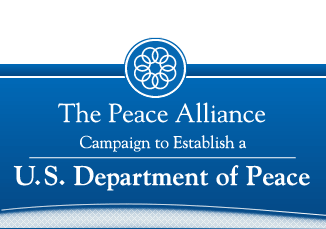
Peace Alliance Logo
Peace, as many point out, is more than an absence of conflict. It must involve those positive forces of conscious harmony that promote justice, freedom, understanding, health and prosperity. Without a physically and psychologically secure basis to life, there is great likelihood for infection by fear, anxiety, envy and superstition, which become seeds of violence. (Mohandas Gandhi wrote that poverty is the worst form of violence.) As a culture, we only now seem to be awakening to the implication of these truths. Domestically and internationally, our practice toward violence has long been to ignore the roots and stalks of the plant until it flowers in crisis. Then we react, meeting violence with violence, while vowing with politically groomed self-righteousness to be tough on crime and terrorists. The results are costly and ineffective.
Enter The Peace Alliance, a citizen-based activist group that has been working quietly for years building support for a Department of Peace. This cabinet-level department in the U.S. Government would pull together the wisdom and resources of experts in conflict resolution and nonviolent communication, augmenting our current problem-solving modalities with skills that are effective at treating root causes of violence.
Experts in the study of violence are turning to an epidemiological model. Rather than stigmatizing and condemning violence where it erupts, we should pay more attention, as with disease, to the many factors that contribute to the incubation of violence. By addressing root causes we would not only more effectively reduce violence, we would also save human resources and money.
Visit The Peace Alliance.
